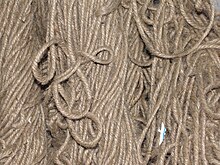
Back جوت Arabic چوت ARZ Jüt (lif) Azerbaijani পাট Bengali/Bangla Jut Breton Juta Czech Джут (чĕлкĕм) CV Jiwt Welsh Jute Danish Jute German



Jute (/dʒut/ JOOT) is a long, rough, shiny bast fibre that can be spun into coarse, strong threads. It is produced from flowering plants in the genus Corchorus, of the mallow family Malvaceae. The primary source of the fiber is Corchorus olitorius, but such fiber is considered inferior to that derived from Corchorus capsularis.[1]
Jute fibers, composed primarily of cellulose and lignin, are collected from bast (the phloem of the plant, sometimes called the "skin") of plants like kenaf, industrial hemp, flax (linen), and ramie. The industrial term for jute fiber is raw jute. The fibers are off-white to brown and range from 1–4 meters (3.3–13.1 ft) long. In Bangladesh, jute is called the "golden fiber" for its color and monetary value.[2]
The bulk of the jute trade is centered in South Asia, with India and Bangladesh as the primary producers. The majority of jute is used for durable and sustainable packaging, such as burlap sacks. Its production and usage declined as disposable plastic packaging became common, but this trend has begun to reverse as merchants and even nations phase out or ban single-use plastics.[3][4]
- ^ "Plants for a Future", Pfaf.org, archived from the original on 20 June 2015, retrieved 21 May 2015
- ^ "The Golden Fiber - Jute Farmers in Bangladesh – DW – 12/06/2023". dw.com. Retrieved 2024-04-12.
- ^ "Single-use plastics ban approved by European Parliament". BBC News. 24 October 2018. Retrieved 1 December 2023.
- ^ Yasir, Sameer (10 October 2022). "That Reusable Trader Joe's Bag? It's Rescuing an Indian Industry". The New York Times. Archived from the original on 11 October 2022. Retrieved 11 October 2022.